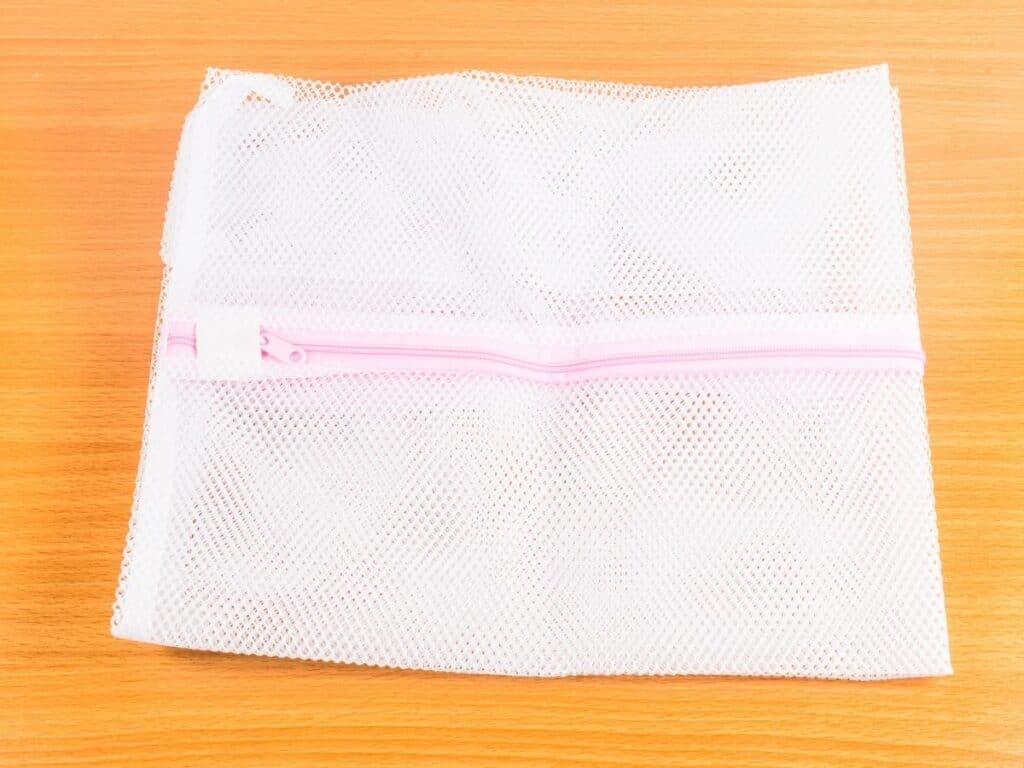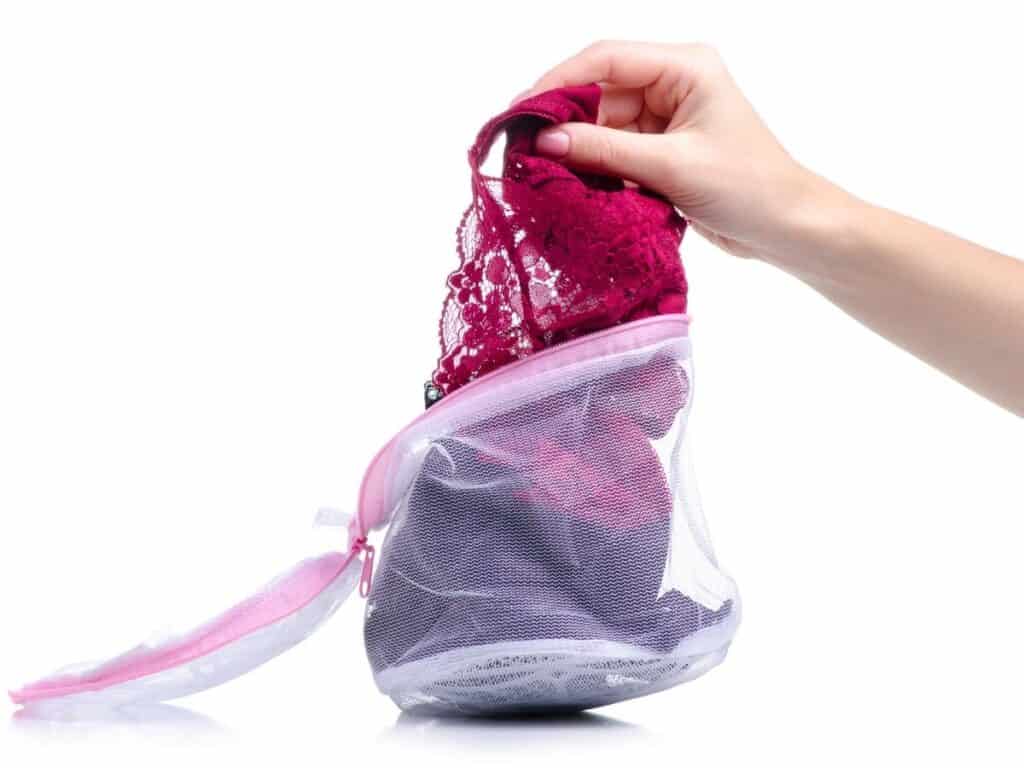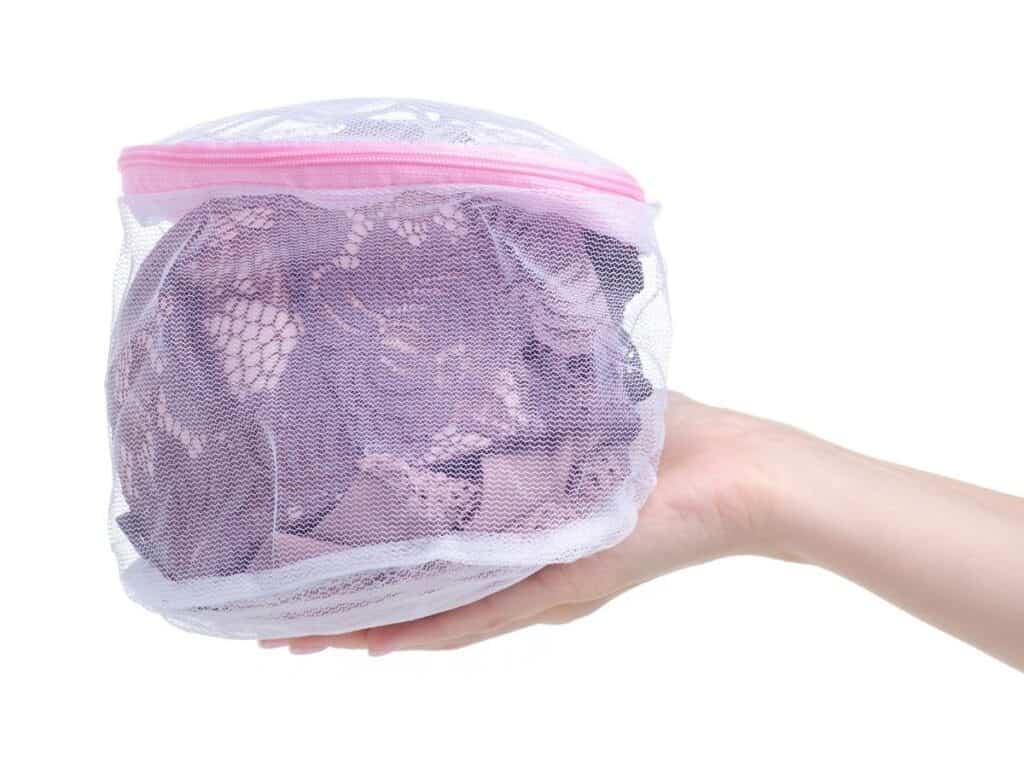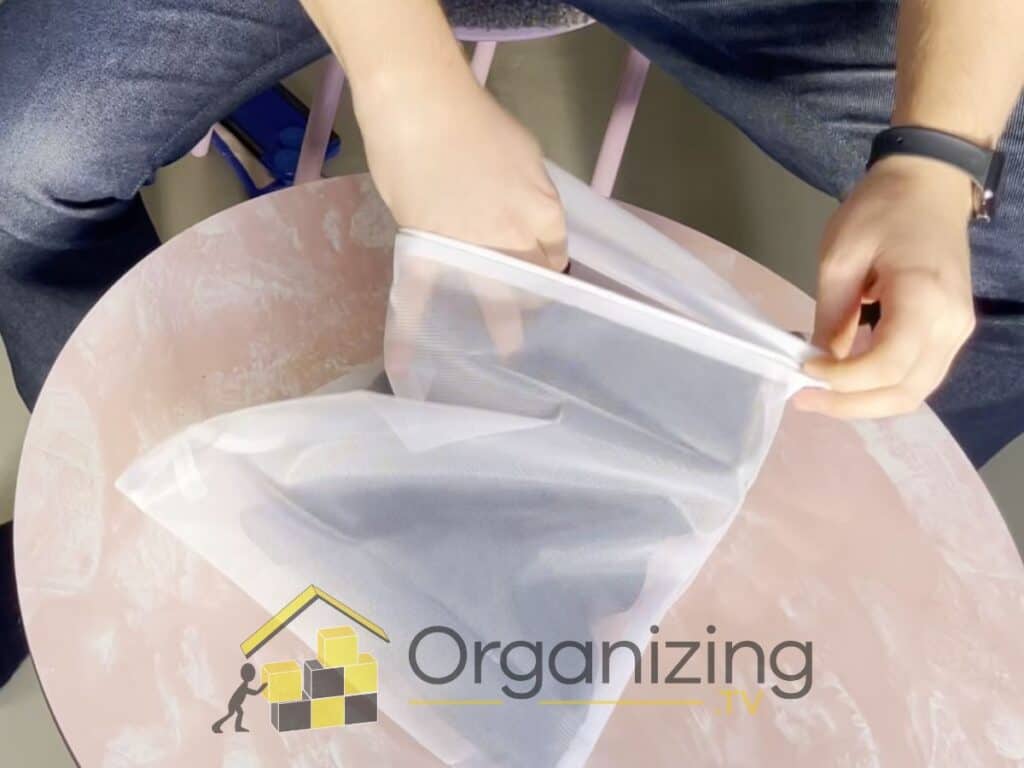Laundry is often classified as either colors or whites. But a more important distinction has to do with the type of fabric itself. A silk blouse or a nylon underwear piece is not the same as a cotton shirt or a pair of denim pants. Treating those four items as equals in the washer and dryer is a perilous decision. You could end up with a frayed blouse, torn underwear, and your precious cashmere garment in tatters.
You need to protect your delicates, athletic clothes, and hosiery with a delicates bag both in the washer and the dryer. Sort the laundry beforehand and wash matching fabrics together. Delicates should be separated into small piles by color and type. After the washer is done, keep the delicates in the laundry bag and dump them into the dryer.
As it turns out, delicates bags are more than an accessory. They play an essential role in protecting your laundry and preventing snags, color runs, and other mishaps in the washer and dryer. Read more to find out how to use a delicates bag.
Why do you Need a Delicates Bag?

If you can imagine the inside of the washer with all the water and laundry detergents mixed together. And if you can imagine your laundry hurtling at high speed and being thrown every other way inside the drum. Now you can get a good idea of what the clothes go through during the hour or so, which makes up the average washing cycle.
If you let your socks wrestle with your jeans, hosiery, delicates, and wool garments, chances are you’ll end up with ripped stockings and a mesh of threads all over the clothes. That’s where a delicates bag comes in. Whether you call it a laundry bag or a delicates bag, these bags separate your laundry by type and color into neat piles to prevent color runs, snags, rips, and damage to the more delicate garments.
A delicates bag is made of durable mesh with a zipped top and extra resistance to heat and the rough and tumble of the inside of the washer and dryer. The sturdy mesh allows water and detergents into the bag but keeps other tough fabrics from coming into contact with the delicates inside.
Types of Delicates Bags
Delicates bags come in a variety of types and sizes to suit. When you think about it, that only makes sense. The fabrics you wash are not the same, and the term “delicates” refers to a wide variety of garments that will be covered below. Naturally, each type of garment needs a different type of delicates bag. So how would you choose the right laundry bag for your specific type of delicates? Here’s the lowdown of the main types (Amazon paid links):
- Zipper Mesh: As the name implies, this type of delicates bag is made of sturdy mesh and has a zipper at the top. Some bags have a double mesh to further protect the laundry inside from the rough and tumble of the drum. The zipper is for more protection.
- Rubber Closure: Similar to zipper mesh bags in terms of design and material but with one difference. Instead of the zipper at the top, these bags come with rubber closures to tighten the mouth of the bag. Zipper mesh bags are easier and more convenient to use.
- Net Clip: This mesh bag has an alligator clip that fastens the mouth of the bag. It is more secure than the rubber closure but still is prone to get lost in the washer or dryer. I recommend zipper mesh delicates bags for durability.
How Delicates Bags Work

Although delicates bags are quite intuitive, there are chances things could go wrong, especially if you use the wrong laundry bag for the nylons or silk garments. Keep in mind that the delicates bag is designed both for the washer and the dryer. The delicates are prone to lint, color runs, and snags in the dryer, just as in the washer.
The mesh walls of the laundry bag are designed to insulate the delicate clothes inside from the rougher clothes outside. The mesh allows the water and detergent in, but the delicates are protected from the swirling water inside of the drum. It’s made of polyester which can tolerate high temperatures and doesn’t wear off easily.
The seal that closes the bag shut is just as important a component as the bag itself. Out of the three types, zippers are the most durable and convenient. Both clips and rubbers are prone to getting lost or becoming undone, especially if the bag is too full.

Finally, you should pay attention to the size of the bag. The larger the bag, the more load capacity it has. In general, delicates bags come in four sizes: 15” x 19”, 18” x 24”, 20” x 30”, and 24” x 36”. The load capacity of the largest size is 26 pounds. That’s enough to take a few velvet jackets and cardigans in one load.
How to Pick a Good Quality Delicates Bag
The more you think about it, the more you realize that delicates bags are a laundry necessity. And since they’re quite cheap, you really have no excuse not to use them.
But the real question is, how to pick a good quality delicates bag. Taking one look at the different options sold online, it’s easy to get confused and end up buying the wrong delicates bag for your specific garments and needs.
To help you choose the right delicates bag for you, follow these tips:
- Don’t buy a delicates bag with drawstrings. The strings are used to tie the bag, but they can also get entangled with other clothes, snag on the drum, and even come undone.
- The mesh should be made of either nylon or polyester with tight holes to minimize friction and exposure to the other fabrics in the washer or dryer.
- Select bags with zippers over those with rubbers or clips. Zippers are more secure and will not get lost.
- Choose a laundry bag with a gusseted bottom. This allows more space and gives the clothes more room to move freely.
- The bag should have a loop to hang it beside the washer or dryer for more convenience.
- Buy laundry bags of different sizes. Using a small bag for the delicates keeps the clothes stuffed which leads to poor washing and drying.
Garments that Need a Delicates Bag
That’s all fine and dandy. We know which delicates bags to buy and how to use them. But what about the type of garments that require laundry bags? Naturally, not all your clothes should go into the same bag.
When you sort them by material and color, you’ll end up with a few piles. Each pile should go into a delicates bag that fits. Then you can decide which piles would go into the washer and dryer together.
In general, the following types of garments need to be washed and dried inside of a delicates bag.
- Hosiery: These types of garments are made of sensitive materials and are usually too flimsy to handle the churning of the washer and spinning of the dryer. They include stockings, thin underwear, thin leggings, and tights.
- Soft Fabrics: All types of velvet, cashmere, silk, and some types of natural wool belong to the soft fabrics category. These garments are sensitive to snags and are more likely to collect lint and other debris in the washer. Instead of hand washing them, you can use the delicates bag.
- Lace: All lacey garments should be treated as delicates and insulated inside a laundry bag that matches their size. This prevents pulling, unraveling, and putting the garments out of shape.
- Activewear and Bathing Suits: The tight-knit fabrics are more likely to stretch if you wash them with jeans and other tougher materials. So keep them in their own bag together. Even if you’re only washing a single pair of yoga pants, it should go into its own bag.
- Embellishments: The frills and lace that embellish dainty garments should have a bag of their own. Even if the garments they’re attached to are sturdy ones, the frills can damage easily if washed with other clothes.
- Socks: Socks are more likely to get lost or entangled with other clothes. But more importantly, you wash socks in a delicates bag to protect other clothes from the lint that the socks produce. Keep all your socks in a neat pile inside of their own bag.
- Denim: What applies to socks also goes for jeans. Jeans are tough fabrics that can easily damage other more fragile clothes. Keep the jeans in a bag to minimize the damage they could inflict on the laundry. They also have buttons and zippers that could break.
- Coats: Coats often have sensitive surfaces that collect lint and cause static inside the washer and dryer. Put the coats in a laundry bag to save yourself a lot of trouble.
I also wrote a more general article on washing clothes without damaging them that may interest you.
How to Use a Delicates Bag

There’s more to using a delicates bag than just keeping expensive clothes separated from the homewear and office outfits. How you sort your laundry before putting it into the washer can go a long way in preserving the integrity of the fabrics, reducing static, and preventing color fading. Follow these steps every time you do the laundry to get the most out of your delicates bags.
- Start by checking the materials of the clothes you’re about to wash together. Fabrics vary in terms of fragility. Keep the rough materials together and the delicate ones in another pile.
- Sort the delicates and group them by material. Silk clothes should go in one bag, cashmere in another bag, velvet in a third, and so on.
- If a garment has a zipper, clip, pin, or large buttons, keep it away from knitwear and wool garments.
- Check for any stains that require pre-treatment. Treat the stains before washing them. This will save you the trouble of rewashing them later.
- Go through the delicates pile you made in Step 1. Sort the delicates by material, color, and fragility. You will have smaller piles. Each pile should have its own delicates bag.
- Turn the clothes inside out before you put them in the bag. This will protect the colors. If the clothes collect lint, it will be on the inside.
- Finally, decide on which bag should go together in the same load. Delicates should have their own load separate from tougher materials like cotton and jeans.
- Set the washer to a gentle washing cycle based on the materials inside of the load.
If you run out of laundry bags and still have other items that need to be bagged, you can use a clean pillowcase as an alternative to delicates bags. A pillowcase will work well with denim and coats as long as they fit inside.
You can learn more about washing your delicates here.
Can you Use a Delicates Bag in the Dryer?
Some people are under the impression that a delicates bag is only for protecting the laundry in the washer. But the dryer also poses some risks for your delicate laundry, just as the washer, if not more. Consider the high speed at which the clothes spin and squeeze together. If you’re washing wool with silk, for example, chances are the silk garment will come out of the dryer covered with a fine web of lint.
The rule of thumb with delicates bags is they start in the washer and continue into the dryer until the dryer cycle is done. This not only protects the laundry against color runs, static, and snags but also saves you a lot of work loading and unloading the washer and the dryer.
Conclusion
Delicates bags are designed to give you better results with the laundry without all the usual problems of snags, color runs, and lint. Choose a delicates bag made of nylon or polyester for its durability. Always sort the laundry by color and material and put each pile in its own bag.
Next, you can check out my article on how to dry your clothes without damaging them over time, or my list of the best laundry detergents for delicates.

I’m an expert wardrobe organizer and a bit of a clean freak. I created this website and its YouTube channel to share practical guides about laundry and organizing. My teachings have been featured in multiple large news publications, and I’ve self-published two wardrobe organizing books and an entire course on the subject.

